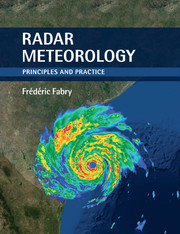Book contents
- Frontmatter
- Dedication
- Contents
- Preface
- Notation
- 1 Meteorology and radar
- 2 Fundamentals of weather radar measurements
- 3 Radar reflectivity and products
- 4 Reflectivity patterns
- 5 Doppler velocity information
- 6 The added value of dual polarization
- 7 Convective storm surveillance
- 8 Monitoring widespread systems
- 9 Radar estimation of precipitation
- 10 Nowcasting
- 11 Additional radar measurements and retrievals
- 12 Cloud and spaceborne radars
- 13 What does radar really measure?
- Appendix A Mathematics and statistics of radar meteorology
- References
- Index
Appendix A - Mathematics and statistics of radar meteorology
Published online by Cambridge University Press: 05 June 2015
- Frontmatter
- Dedication
- Contents
- Preface
- Notation
- 1 Meteorology and radar
- 2 Fundamentals of weather radar measurements
- 3 Radar reflectivity and products
- 4 Reflectivity patterns
- 5 Doppler velocity information
- 6 The added value of dual polarization
- 7 Convective storm surveillance
- 8 Monitoring widespread systems
- 9 Radar estimation of precipitation
- 10 Nowcasting
- 11 Additional radar measurements and retrievals
- 12 Cloud and spaceborne radars
- 13 What does radar really measure?
- Appendix A Mathematics and statistics of radar meteorology
- References
- Index
Summary
Many branches of meteorology rely heavily on mathematics to help explain and describe phenomena. Most, especially those rooted in atmospheric dynamics, primarily use calculus and differential equations; as a result, these mathematical concepts are well taught and often used in meteorology programs and courses. In many ways, the mathematical foundations of instrumentation in general and of radar in particular are more basic, being rooted in geometry, algebra of real and complex numbers, and introductory statistics. But since these do not get applied as much in meteorology programs, they tend to be forgotten. Furthermore, geophysical fields such as winds and rainfall pose special challenges to their analysis that are often ignored in introductory statistics courses, leading to mistakes that are too often observed even in scientific publications. This section introduces some of these topics by focusing on particular radar research problems that require a specific mathematical treatment or statistical approach to study them, and use these problems as means to introduce the relevant mathematical or statistical concepts. It will, however, not be a complete surrogate to proper reference texts in mathematics and statistics, but should hopefully help the reader ask the right questions and find the relevant material in these books. This appendix also gives me the opportunity to complement or introduce topics that could not be easily covered in previous chapters.
Geometry of ground-based radar measurements
To interpret or simulate radar measurements, it is essential to understand the complexity of the geometry of radar measurements. This complexity is due, among others, to the fact that both the radar measurements and the Earth-centric coordinate system follow different near-spherical geometry. On the one end, radar makes measurements in range–azimuth–elevation (r, ϕ, θ) along beams that have widths and that bend due to propagation in the atmosphere. On the other end, the position and axis of measurement must be reported with respect to an Earth-centric coordinate system such as latitude–longitude–height (Lp, lp, z), where the pointing direction of axes such as “east” and “up” changes from location to location because of the curvature of the Earth.
- Type
- Chapter
- Information
- Radar MeteorologyPrinciples and Practice, pp. 215 - 243Publisher: Cambridge University PressPrint publication year: 2015



